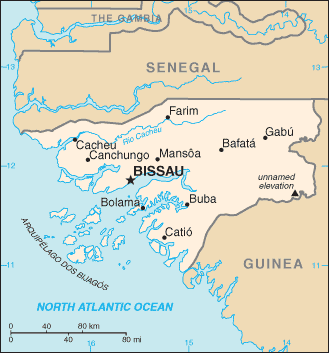|
Guinea-Bissau
|

|
Capital: Bissau
Population: 1,920,922
Brief History of Guinea-Bissau:
Portugal claimed the area that is today Guinea-Bissau in the 15th century. It was one of the first areas explored by the Portuguese. However, even though Portugal claimed the area in 1446, they did not start trading and settling the area until the 1600s. At that time, the area became a major supplier of slaves. The Cape Verde islands were used as a major slave trading center.
In the 19th century, the area was divided up between the French, British, and the Portuguese. Guinea-Bissau was the Portuguese portion.
In 1974 Guinea-Bissau gained full independence from Portugal. Since that time the country has been marred with unrest, civil wars, and military coups.
The Geography of Guinea-Bissau
Total Size: 36,120 square km
Size Comparison: slightly less than three times the size of Connecticut
Geographical Coordinates: 12 00 N, 15 00 W
World Region or Continent: Africa
General Terrain: mostly low coastal plain rising to savanna in east
Geographical Low Point: Atlantic Ocean 0 m
Geographical High Point: unnamed location in the northeast corner of the country 300 m
Climate: tropical; generally hot and humid; monsoonal-type rainy season (June to November) with southwesterly winds; dry season (December to May) with northeasterly harmattan winds
Major cities: BISSAU (capital) 302,000 (2009)
The People of Guinea-Bissau
Type of Government: republic
Languages Spoken: Portuguese (official), Crioulo, African languages
Independence: 24 September 1973 (unilaterally declared by Guinea-Bissau); 10 September 1974 (recognized by Portugal)
National Holiday: Independence Day, 24 September (1973)
Nationality: Guinean(s)
Religions: indigenous beliefs 50%, Muslim 45%, Christian 5%
National Symbol:
National Anthem or Song: Esta e a Nossa Patria Bem Amada (This Is Our Beloved Country)
Economy of Guinea-Bissau
Major Industries: agricultural products processing, beer, soft drinks
Agricultural Products: rice, corn, beans, cassava (tapioca), cashew nuts, peanuts, palm kernels, cotton; timber; fish
Natural Resources: fish, timber, phosphates, bauxite, clay, granite, limestone, unexploited deposits of petroleum
Major Exports: cashew nuts, shrimp, peanuts, palm kernels, sawn lumber
Major Imports: foodstuffs, machinery and transport equipment, petroleum products
Currency: Communaute Financiere Africaine franc (XOF); note - responsible authority is the Central Bank of the
National GDP: $1,925,000,000
** Source for population (2012 est.) and GDP (2011 est.) is CIA World Factbook.
Back to Geography Home Page
